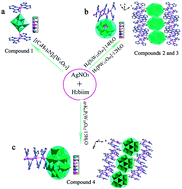By introducing different polyoxotungstates into the Ag–H2biim system, four new compounds with distinct architectures, Ag2(H2biim)4(W6O19)·2H2O (1), Ag6(H2biim)6(SiW12O40)(OH)2·2H2O (2), Ag6(H2biim)6(PW12O40)(OH)3·H2O (3) and Ag6(H2biim)6(P2W18O62)·12H2O (4) (H2biim = 2,2′-biimidazole), have been hydrothermally synthesized, and characterized by routine physical methods and single crystal X-ray diffraction. In compound 1, the Lindqvist type polyoxotungstate {W6} combines with the chelate Ag–H2biim complex forming a discrete “dumbbell-like” motif. Isostructural compounds 2 and 3 are obtained by introducing Keggin polyoxotungstates ({SiW12} and {PW12}, respectively), which show a 2D layer structure. The 2D layers parallel each other to form a 3D supramolecular framework. The larger Wells–Dawson polyoxotungstate {P2W18} directs the formation of compound 4, in which one 2D layer is the inversion of the neighboring ones. Furthermore, there exist infinite Ag chains in compounds 2–4, which are quite unusual in POM-based compounds. The distinction among the final four architectures is ascribed to the structure-directing effect of different polyanions. The electrochemical properties of compounds 1–4 are studied. In addition, the antibacterial properties of the four compounds against negative Escherichia coli (E. coli) and positive Staphylococcus aureus are investigated.

You have access to this article
 Please wait while we load your content...
Something went wrong. Try again?
Please wait while we load your content...
Something went wrong. Try again?


 Please wait while we load your content...
Please wait while we load your content...